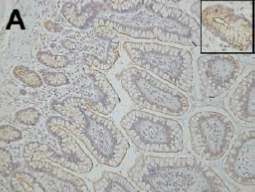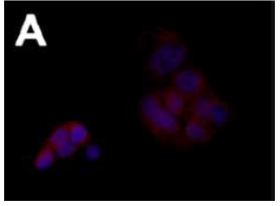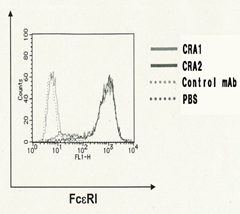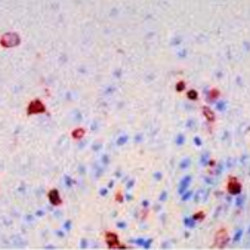Description
Background:
FcεR1α is subunit of the high affinity receptor for IgE to which IgE directly binds. FcεR1 is a tetrameric complex consisting of one α, one β and two γ subunits. The latter two subunits are required for signal transduction activity. The FcεR1αcomplex plays an important role in triggering allergic responses.
The CRA1 (AER37) monoclonal antibody reacts with the FcεR1αsubunit on a region that does not overlap the region of the IgE binding site, thus it does not compete with IgE for the receptor binding. Since the CRA2 (AER24) monoclonal antibody reacts with the IgE binding site on FcεR1α, it competes with IgE for the receptor binding. Combining the two antibodies, one can quantitatively measure the amounts of the IgE-bound FcεR1α.
This product is the IgG fraction purified from serum-free culture medium of mouse hybridoma (CRA1) by propriety chromatography under mild conditions. Properties of CRA1 and CRA2 antibodies have been extensively characterized by Prof. Chisei Ra (Ref. 3,4).
Specifications:
Reactivity: human, house musk shrew
Immunogen: Recombinant extracellular portion of human FcεR1α(corresponding to amino acids Met-26-197, where signal peptide is 1-25)
Epitope: 26-110 amino acids
Isotype: IgG2b
Form: Purified monoclonal antibody (IgG) 1mg/ml in PBS (pH 7.4), 50% glycerol, filter-sterilized, azide and carrier free
Storage: Ship at 4℃ and store at -20℃ (Do not store below -20℃)
Applications:
- Western blotting (~1ug/ml)
- Immunoprecipitation (assay dependent)
- Flow Cytometry (FC) (1~5 ug/ml)
- IHC-P, IHC-F (~1 ug/ml)
- Titration of IgE-bound receptor in combination with CRA2 antibody (Ref.3)
- Promotion of migration of basophils (Ref.5)
IData Link: UniProtKB/Swiss-Prot P12319 (FCERA_HUMAN)

Fig.1 Western blot analysis of FcεRαexpression induced by TH-2 cytokines in neutrophils
from allergic asthmatics. Total protein lysates were subjected to immunoprecipitation with IgE/anti IgE and Western blotting with CRA1. Basophilic cell line (KU812) was used as positive control. Negative control corresponds to neutrophil protein lysate analyzed without IgE/anti-IgE immunoprecipitation. (Image from Alphonse MP et al. PLoS One. 2008 Apr 2;3(4): e1921.)

Fig.2 Immunohistochemical staining of FcεRα in section from intestinal tissue. (A) FcεRαis detected on the membrane, as well as in the cytoplasm of epithelial cells in small intestine of a cancer patient.
(Cited from: Untersmayr E et al. (2010) PLoS ONE 5(2): e9023.)

Fig.3 Immunofluorescence staining of FcεRα in human intestinal tumor cell line. Abundant surface and cytoplasmatic FcεRI α expression is observed only in subconfluent Cao2/TC’ cells (red). The cells were permeabilized withTriton-X-100.
As the second antibody, goat anti-mouse AlexaFluor 568 was used. Nuclei were stained with DAPI.
(Cited from: Untersmayr E et al. (2010) PLoS ONE 5(2): e9023.)

Fig.4 Flow-cytometry of CHO/FcεR1αcells with CRA1 and CRA2 antibodies. CHO cells were transfected with plasmid expressing human FcεRIα. The second antibody is FITC-conjugated anti-mouse IgG2b antibody.
References: This antibody has been used in the following publications.
- Suzuki K. et al. The Fc receptor (FcR) γsubunit is essential for IgE-binding activity of cell-surface expressed chimeric receptor molecules constructed from human high-affinity IgE receptor (FcεRI) αand FcRγ Mol Immunol. 1998 Apr;35(5):259-70. WB,IP (human)
- Yamaguchi M et al. IgE enhances Fc epsilon receptor I expression and IgE-dependent release of histamine and lipid mediators from human umbilical cord blood-derived mast cells: synergistic effect of IL-4 and IgE on human mast cell Fc epsilon receptor I expression and mediator release.J Immuno1 162:5455-5465 (1999) PMID: 10228025 FC (human)
- Hasegawa S et al. Functional Expression of the High Affinity Receptor for IgE (FceRI) in Human Platelets and Its’ Intracellular Expression in Human Megakaryocytes” Blood 93;:2543-51 (1999) PMID: 10194433 FC (human)
- Takai T et al. Epitope analysis and primary structures of variable regions of anti-human FcepsilonRI monoclonal antibodies, and expression of the chimeric antibodies fused with human constant regions. Biosci Biotechnol Biochem 64:1856-1867(2000) PMID: 055388 WB, FC (human)
- Takai T et al.“Direct expression of the extracellular portion of human FcepsilonRIalpha chain as inclusion bodies in Escherichia coli. Biosci Biotechnol Biochem 65:79-85 (2001) PMID: 11272849 WB (human)
- Suzukawa M et al. IgE- and FcepsilonRI-mediated migration of human basophils. Int Immunol 17 : 1249-1255 (2005) PMID: 16103029 Induction migration of basophils (human)
- Koketsu R et al. Activation of basophils by stem cell factor: comparison with insulin-like growth factor-I. J Investig Allergol Clin Immunol. 2008;18(4):293-9. PMID: 18714538 Basophil histamine release (human)
- Alphonse MP et al Regulation of the high affinity IgE receptor (Fc epsilonRI) in human neutrophils: role of seasonal allergen exposure and Th-2 cytokines. PLoS One.2008 Apr 2;3(4):e1921. doi: 10.1371/journal.pone.0001921. PMID: 18382690. WB, IF, FC (human)
- Untersmayr E. The high affinity IgE receptor Fc epsilonRI is expressed by human intestinal epithelial cells. PLoS ONE 5 (2):1-11 (2010) PMID:20126404 IHC-P, IF (human)
- Ono HK et al. Submucosal mast cells in the gastrointestinal tract are a target of staphylococcal enterotoxin type A. FEMS Immunol Med Microbiol.2012 Apr;64(3):392-402. PMID:22211567. IHC-F (house musk shrew)
- Ito R et al. Establishment of a Human Allergy Model Using Human IL-3/GM-CSF–Transgenic NOG Mice. J Immunol.2013 Sep 15;191(6):2890-9. PMID: 23956433 IHC-P (human)
- Ogihara K et al. Inhibition of an Allergen–Antibody Reaction Related to Japanese Cedar Pollinosis Using DNA Aptamers Against the Cry j 2 Allergen. Nucleic Acid Therapeutics. November 2015, 25(6): 311-316. PMID: 26484654 WB (human)
Related products:
- # 72-003 Anti- FcεR1α(human IgE receptor)monoclonal (CRA1), biotinylated
- # 72-004 Anti- FcεR1α(human IgE receptor)monoclonal (CRA1), FITC conjugated
- # 72-005 Anti- FcεR1α(human IgE receptor)monoclonal (CRA2)
- # 72-007 Anti- FcεR1α(human IgE receptor)monoclonal (CRA2), biotinylated
- # 72-008 Anti- FcεR1α(human IgE receptor)monoclonal (CRA2), FITC conjugated



Reviews
There are no reviews yet.